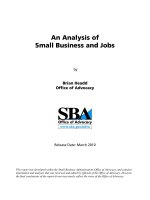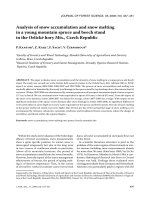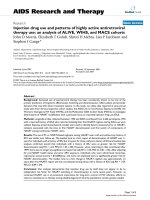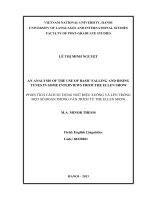An analysis of the use of basic falling and rising tunes in some interviews from The Ellen Show
Bạn đang xem bản rút gọn của tài liệu. Xem và tải ngay bản đầy đủ của tài liệu tại đây (111.76 KB, 6 trang )
An analysis of the use of basic falling and rising
tunes in some interviews from The Ellen Show
Lê Thị Minh Nguyệt
Trường Đại học Ngoại ngữ
Luận văn ThS. Chuyên ngành: English Linguistics; Mã số: 60 22 15
Người hướng dẫn: Ha Cam Tam, Ph.D
Năm bảo vệ: 2013
Abstract: How to speak English with the appropriate intonation? How to teach and learn English
intonation effectively and properly? etc. They are always big questions under restless mind of
English teachers and learners not only in Viet Nam but also in the English-speaking words.
There has been existing a traditional so-called correlation between intonation tunes and sentence
types such as Declarative, Interrogative and Imperative Sentences in the practice of English
teaching. The current paper presents another effort to verify this myth by analyzing the use of
tunes and the sentence types in the conversations selected from the most popular Television talk
show in American- the Ellen Show. By closely examining the bulk of 872 intonation units, this
study point out the dominance of falling tunes in real-life conversations. More importantly, the
research results supports the correlation between certain sentence types and some specific tunes
while underlines the inconsistence in the use of falling and rising tunes and other sentence types
under different circumstances.
Keywords: Tiếng Anh; Ngữ điệu; Kỹ năng nói; Phỏng vấn
Content
PART ONE: INTRODUCTION
To start with, in this very first part of the thesis, the readers would find background
information to the study. The historical context of the intonation issue with relevant theories and
the justifications for implementing this study would be presented first, then come the aims and
research questions of the study. The third part concerns with the scope of the study, followed by
the methods and significance of this research. A brief description on the organization of this
minor study wraps up the Introduction part.
1. RATIONALE
Intonation has always been the mysterious and promising woods which has inspired a
great deal of exploration, arguments and mediation to achieve a satisfactory agreement on its
nature as well as values in languages. Intonation, the so-called „melody of speech‟
(Roach,2001), is „what you had when the prose was spoken‟ (Couper-Kuhlen,2007).
In the past fifty years, intonation has been steadily acknowledging its indispensable roles
and values in communication via the tool of languages. During this process, the works centering
on the issues of intonation has recorded numerous changes from both theoretical and practical
perspectives, some of which are currently far from a final conclusion. While traditional
viewpoints simply equate intonation with „the use of the pitch of the voice to convey linguistic
information‟ (Gilbert, 1987), the more recent and contemporary linguists argue about a far more
complex nature of intonation, as Roach (2009: 43) claims: “in its broader and more popular sense
it is used to cover much the same field as „prosody‟, where variations in such things as voice
quality, tempo and loudness are included.”
With that vivid transformation and nonstop development as well as the increasingly
important roles in linguistics, intonation is currently an appealing topic for further research. It is
not difficult to find that the majority of linguistics research on intonation is devoted to the
functions of intonation. Roach (1991: 163) defines four functions of intonation: to express
emotions and attitude as we speak – attitudinal function, to produce the effect of prominence on
syllables – accentual function, to recognize the grammar and syntactic structure of what is being
said – grammatical function, and to signal to the listener what is “new” and “given”
information”. Crystal (1969:254) discusses the grammatical and semantic functions of intonation
as follows:
„grammatical considerations are relevant for the study of intonation in so far as it can be
shown that a given grammatical structure has a regular correlation with a given intonational
pattern, and that a change in intonation causes one to re-label (re-interpret) the syntactic structure
of an utterance, no other morphological change being necessary‟.
In contrast, a number of phonologists believe that this function is incapable by itself to provide
adequate account for certain intonational patterns. A wide range of linguistic works (Roach, O‟Connor
& Arnold, Crystal, Halliday, Cruttenden) suggest a strong tendency to have falling tone in statements
and WH-questions and rising tone in Yes/No questions, but also assert that the “generalizations are too
broad” and this traditional view only scratches the surface”.
This controversial issue, at the same time, causes great confusion and nuisance for
the learners and teachers of English as a foreign language, which the writer as a novice
teacher has been experiencing. There‟s still a need for an appropriate guideline on the
correlation of the tunes and the grammatical structures of utterances. This is particularly
meaningful and importance in the case of EFL learning and teaching in VietNam, where
intonation is an exotic concept to the Vietnamese linguistic reservoir of EFL learners as
well as teachers.
Moreover, most the previous studies on intonation are based on read-aloud conversations
or speech, sometimes isolated utterances from official corpus (Ladd, 1985 as an example).
Therefore, a closer look into naturally-occurring discourse can hopefully be contributable to the
field of intonation and to the writer particularly. The extracts of two-or- three speaker interviews
from the show, an American television talk show hosted by comedian/actress Ellen DeGeneres
with the best-known celebrities all over the world provide the research with a varied accents and
extremely colorful cultural background. The show has won 32 Daytime Emmy Awards as of
2011. The 10th season of the show, from which the selected excerpts are taken, began on
September 10, 2012.
In a nutshell, the significance of intonation tunes in successfully communication together
with the desire of the author as a EFL teacher to obtain an empirically-driven and efficiency
framework to teach intonation to her students are the justifications behind the choice of the
current paper topic.
2. AIMS OF THE STUDY AND RESEARCH QUESTIONS
The primary purpose and aim of the current study is to provide a closer look into the use
of falling and rising tunes in the context of a real-life talk show, which would be the closest form
of naturally occurring conversation. The author would like to discover the frequency of falling
and rising tunes in the free-style chat show to partially establish a conclusion about the
dominance of these two tones in English conversations. Moreover, another issue to be cleared
out is the long-in-dispute problems of correlation between the tunes employed and different
sentence types, including Declarative, Wh-Interrogative, Yes/No Interrogative and Imperative.
The degree of correlation, which would pave the way to the formation of a generalization for the
correlation, then is another aim of the study.
Therefore, this minor research target to research questions as follows:
1. How frequently are falling and rising tunes used in the selected interviews from the
Ellen Show?
2. Is there a correlation between the falling and rising tunes and sentence types at the
level of intonation unit? If yes, how is the correlation realized?
3. SCOPE OF THE STUDY
Under the scope of this mini study, the author would closely examine the use of
falling and rising tunes as well as the relationship between the tunes and the syntactic structures
of the intonation units. To mention the materials for the data collection and analysis, the author
would selectively analyze 10 two-speaker or three-speaker interview extracts from the interviews
with the highest viewings from the Ellen Show website.
4. METHODS OF THE STUDY
As far as the method is concerned, there were two different types of methods employed to
obtain the data and reach the conclusion of this study. In the first stage, the author used analytical
methods to observe the intonation patterns of utterances in the extracts and analyze their
functions. Then, quantitative method took over the main role in synthesizing the statistics
collected from the descriptive step.
5. SIGNIFICANE OF THE STUDY
Hopefully, the writer can find her own minor study meaningful and helpful, despite to a
very small extent, to the area of intonation research as well as intonation as a component of
English language, users-learners and teachers in some following aspects:
5.1. To the area of intonation research
- To build up the enormous literature on intonation of English with another moderate
empirical effort. In particular, this study is hoped to enrich the naturally-occurring discourse
analysis on intonation
- To provide an new evidence on the frequency of falling and rising tunes as two basic
tunes of the language of English
5.2. To language user-learners and teachers
Teachers and learners always desire for a guideline to perceive and appropriately use
intonation as a tool for conveying communicative messages. Therefore, the expected findings of
the study, the frequency of falling and rising tunes and the correlation between the tune choice
and syntactic features of the intonation units are hopefully supposed to
- promote the awareness of language teachers and learners as users of English about the
need to understand and use these tones in communication.
- offer a helping hand in deciding the tone choice as speakers and understanding the
message as listeners.
6. ORGANISATION OF THE STUDY
The thesis is composed with 3 main parts:
Part one: Introduction states the reasons for conducting research, the aims of the study
along with the research questions as well as the method of doing research, the scope of the study
and the organization of this current report.
Part two: Development includes two chapters.
In chapter one: Literature Review, some theories related to intonation and the framework
for this study will be discussed. Then, the previous research related to intonation would be
reviewed in order to show the research gap and the need to conduct this work.
The second chapter- The study is the main core of this research paper. There are two
sections: Methodology and Data Analysis & Discussion.
Section 1- Methodology once again highlights the research questions. The data collection
description and procedure are discussed in detailed here, followed with the analytical framework
for the current study.
Section 2: Data Analysis & Discussion presents the research results which include the
frequency of falling and rising tunes in the corpus of the interview extracts and the correlation
between these two tunes with the syntactic structure of the utterances. In this chapter, the
researcher also discusses the answers to the posed research questions and provides a comparison
between the findings of the current study with the previous study.
Part three: Conclusion summarizes the main contents of the research paper – what has
been done throughout the research. Implications, limitations of the research along with
suggestions for further studies are also proposed.
REFERENCES
1. Brazil, D. (1997). The communicative value of intonation in English.Cambridge: Cambridge
University Press.
2. Boersma, P.&Weenink, D. (2011). Praat: Doing phonetics by computer. [Computer
Software] Amsterdam: Department of Language and Literature, University of Amsterdam.
Retrieved from
3. Couper-Kuhlen, E.(2003). Intonation and Discourse: Current Views from Within. The
Handbook of Discourse Analysis.Blackwell Publishing.Blackwell Reference Online.13
December
2007 />97806312059682.
4. Cruttenden, A. (1986). Intonation.Cambridge: Cambridge University Press.
5. De Bot, K.&Mailfert, K. (1982). The teaching of intonation: Fundamental research and
classroom applications. TESOL Quarterly, 16, 71-77.
6. Gardner, R. (2008). Conversation Analysis and orientation to learning.Journal of Applied
Linguistics.Volume 5-3 2008, 229-244
7. Guo,J. & Shi, F. (2011). The Fluctuation scale of the Intonation of Statement and
Declarative Question in English.Proceedings of the XVIIth International Congress of
Phonetic Science.
8. Hasselgård, H. & Lysvåg, P. & Johansson, K.A.S. (2012). English Grammar - Theory and
Use. Second edition. Universitetsforlaget.
9. Hayes, B. (2009). Introductory Phonology.WestSussex: Blackwell Publishing.
10. Huynh, L. T. (2012). Question intonation patterns in a real-life conversation and in textbook
dialogs. TESOL Working Paper,Series 10, 83-92. Hawaii Pacific
University..
11. Iwasaki, S. (1996). The syntactic and functional structures of intonation unit in Thai. The
Fourth International Symposium on Language and Linguistics, 750-761. Thailand: Institute
of Language and Culture for Rural Development, Mahidol University.
12. Kumaki, K. (2003). A Study of English Intonation in High School Textbooks in Japan.MA
Dissertation. UK: University of Birmingham.
13. Ladd, R. (2008). IntonationalPhonlogy.Cambridge: Cambridge University Press.
14. Lane, L. (2010). Tips for Teaching Pronunciation: A Practical Approach. Pearson Longman.
15. Megdad, B.I.S. (2012). Difficulties Facing English Department Juniors at IUG in Learning
Intonation. Master Thesis. The Islamic University of Gaza.
16. Pejčić, A. (2012). What do We Believe? Prosodic Correlates of Persuasive Speech in Serbian
and English Political Discourse. Master Thesis. University of Niš.
17. Oladipupo, R.O. (2010). The Intonation of Noun Phrase Subjects and Clause-Modifying
Adverbials in Nigerian English.African Research Review. Vol. 4(3b), 167-178.
18. Reed, B.S. (2009). Units of interaction: „Intonation phrases‟ or „turn constructional
phrases‟?.Proceedings of IDP 09.
19. Roach, P. (1991). English Phonetics and Phonology: Practical Course (1
st
Ed). Cambridge:
Cambridge University Press.
20. Roach, P. (2001).English Phonetics and Phonology: Practical course ( 3
rd
Ed).Cambridge:
Cambridge University Press
21. Roach, P. (2009). English Phonetics and Phonology: Practical course (4
th
Ed),Cambridge:
Cambridge University Press.
22. Snow, D & Balog, H.L. (2002). Do children produce the melody before the words? A review of
developmental intonation research.Lingua 112, 1025-1058.
23. Tench, P. (1996). The Communicative Value of the tone system of English. Proceedings of
the 9th International Symposium on Theoretical and Applied Linguistics, , p149-165.
Thessaloniki: Aristotle University.









